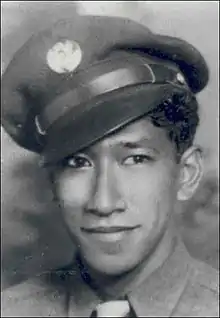David Akui
David M. Akui (January 16, 1920 – September 15, 1987) was an American soldier who became famous for capturing the first Japanese prisoner of war in World War II. At the time, Akui was a corporal in Company G, 298th Infantry Regiment of the Hawaii National Guard.[1]
David M. Akui | |
|---|---|
 | |
| Born | January 16, 1920 |
| Died | September 15, 1987 (aged 67) Kaneohe, Honolulu, Hawaii |
| Allegiance | |
| Service/ | |
| Years of service | 1940–1945 |
| Rank | Master sergeant |
| Unit | Hawaii National Guard 5307th Composite Unit |
| Battles/wars | World War II |
Biography
- This section appears to be missing information. If you have a reliable source that documents the rest of his life, please add it in.
Hawaiian native Akui enlisted on 15 October 1940[2] and would serve in the Pacific theater until its end.
On December 8, 1941, the morning after the Japanese attack on Pearl Harbor, Akui and Lieutenant Paul C. Plybonwas were walking along Waimanalo Beach when Akui found a Japanese man lying unconscious on the beach. The man awoke to find Akui standing over him with a drawn pistol.[3][4] Akui took the man into custody and he was identified as Ensign Kazuo Sakamaki, commander of a two-man midget submarine that took part in the Pearl Harbor attacks.[1] Ensign Sakamaki's submarine's gyrocompass was malfunctioning and caused the submarine to sail in circles at periscope depth. Sakamaki thus ran aground on a reef, where the United States Navy destroyer USS Helm spotted it and opened fire.[5] The destroyer's gunners missed, but the blasts freed the submarine from the reef and Sakamaki was able to submerge. When he could not repair the gyrocompass, Sakamaki ordered Petty Officer 2nd Class Kiyoshi Inagaki to swim ashore, while he set the demolition charges to destroy the submarine. Sakamaki then abandoned ship himself. Inagaki drowned attempting to swim ashore. Sakamaki succeeded, but passed out from exhaustion. Corporal Akui found him there.[5] Sakamaki's demolition charges failed to explode and his submarine also washed ashore. It was salvaged and is now in the Admiral Nimitz Museum at Fredericksburg, Texas.[5]
Akui served through the remainder of the war in the Pacific Theater and was a member of the famed "Merrill's Marauders", who fought the Japanese in the jungles of Burma.[6][7][8] He retired from the United States Army as a master sergeant and spent the rest of his life in Hawaii. He died in Kaneohe, Honolulu in 1987 at the age of 67.[6]
References
- Hawaii, State of (2005–2008). "[History of] Bellows Field". the State of Hawaii. Retrieved 2008-07-14.
- "NARA, Enlistment Records, ca. 1938 - 1946". aad.archives.gov. Retrieved 15 June 2010.
- Goldstein, Richard (1999-12-21). "Kazuo Sakamaki, 81, Pacific P.O.W. No. 1". The New York Times. Retrieved 2008-07-14.
- Underwood, George (1997). "The Tenth Man". Submariners News. Archived from the original on 2008-06-07. Retrieved 2008-07-14.
- Goldstein, Richard (1999-12-21). "Kazuo Sakamaki, 81, Pacific P.O.W. No. 1". The New York Times. Retrieved 2010-05-01.
- National Guard. "Today in History, December". The National Guard. Archived from the original on 2008-12-05. Retrieved 2008-07-14.
- "Archived copy". Archived from the original on 2011-10-02. Retrieved 2011-12-11.CS1 maint: archived copy as title (link)
- http://ibiblio.net/hyperwar/USA/USA-CBI-Time/USA-CBI-Time-7.html%5B%5D
Further reading
- Arakaki, Leatrice R.; Kuborn, John R. (1991). 7 December 1941, The Air Force Story (Pearl Harbor). Washington D.C.: U.S. Government Printing Office. pp. 142–146.